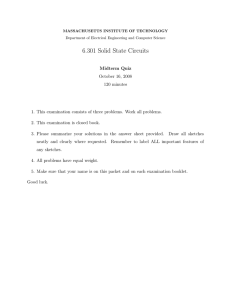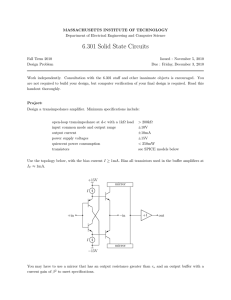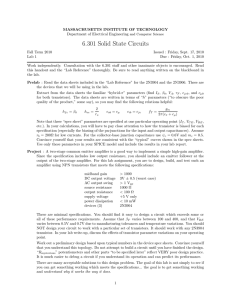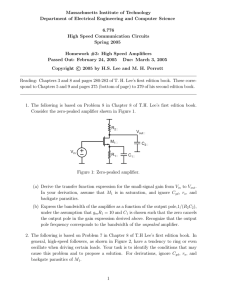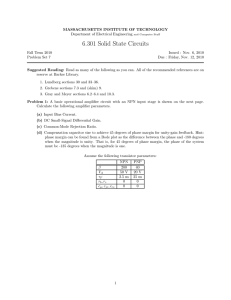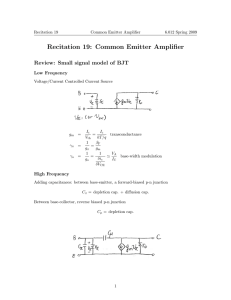Mechatronics 2.737 Assignment 2: Analog Feedback Systems Laboratory
advertisement
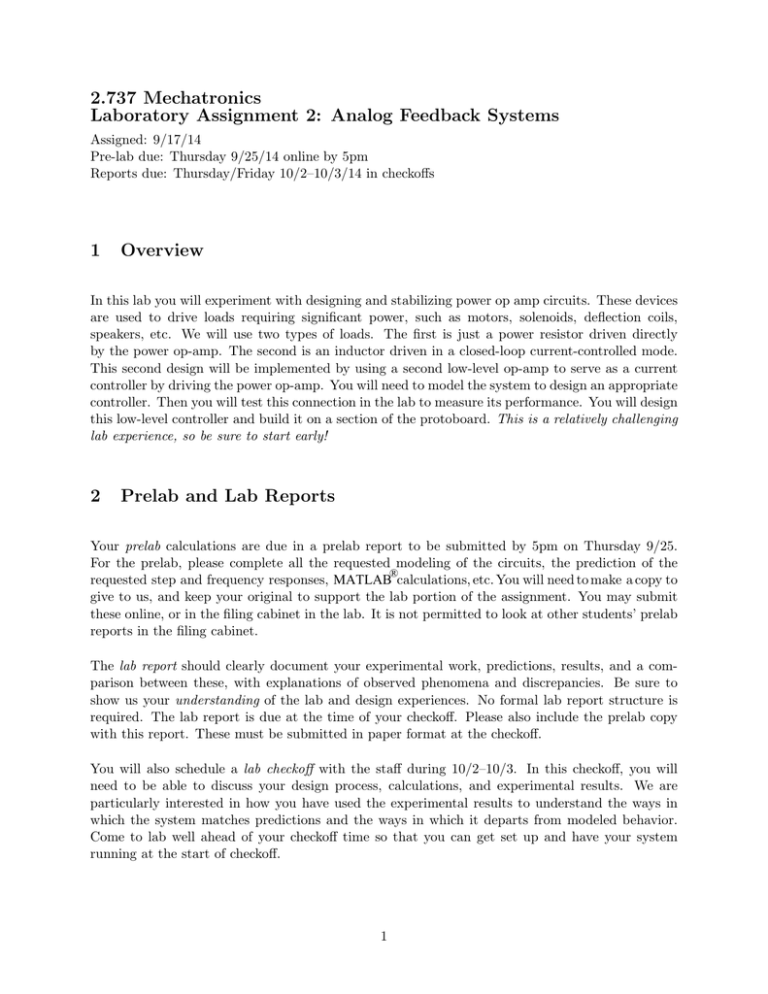
2.737 Mechatronics Laboratory Assignment 2: Analog Feedback Systems Assigned: 9/17/14 Pre-lab due: Thursday 9/25/14 online by 5pm Reports due: Thursday/Friday 10/2–10/3/14 in checkoffs 1 Overview In this lab you will experiment with designing and stabilizing power op amp circuits. These devices are used to drive loads requiring significant power, such as motors, solenoids, deflection coils, speakers, etc. We will use two types of loads. The first is just a power resistor driven directly by the power op-amp. The second is an inductor driven in a closed-loop current-controlled mode. This second design will be implemented by using a second low-level op-amp to serve as a current controller by driving the power op-amp. You will need to model the system to design an appropriate controller. Then you will test this connection in the lab to measure its performance. You will design this low-level controller and build it on a section of the protoboard. This is a relatively challenging lab experience, so be sure to start early! 2 Prelab and Lab Reports Your prelab calculations are due in a prelab report to be submitted by 5pm on Thursday 9/25. For the prelab, please complete all the requested modeling of the circuits, the prediction of the ® requested step and frequency responses, 0$7/$% calculations, etc. You will need to make a copy to give to us, and keep your original to support the lab portion of the assignment. You may submit these online, or in the filing cabinet in the lab. It is not permitted to look at other students’ prelab reports in the filing cabinet. The lab report should clearly document your experimental work, predictions, results, and a com­ parison between these, with explanations of observed phenomena and discrepancies. Be sure to show us your understanding of the lab and design experiences. No formal lab report structure is required. The lab report is due at the time of your checkoff. Please also include the prelab copy with this report. These must be submitted in paper format at the checkoff. You will also schedule a lab checkoff with the staff during 10/2–10/3. In this checkoff, you will need to be able to discuss your design process, calculations, and experimental results. We are particularly interested in how you have used the experimental results to understand the ways in which the system matches predictions and the ways in which it departs from modeled behavior. Come to lab well ahead of your checkoff time so that you can get set up and have your system running at the start of checkoff. 1 3 Collaboration You are welcome to collaborate freely with other students in the class, to discuss approaches and solutions, and compare results. However, what you turn in for prelab and lab reports must represent your individual understanding. We require that you fabricate your own circuits and controllers, and do your own experimental lab work, as watching someone else is not very effective. The checkoffs are one-on-one, and give you a chance to show us your own understanding of the material. If you make use of insights from another student, good scholarship entails citing their contribution in your report. It is always good form to acknowledge such assistance; it makes you a better scholar as well as being fair. 4 Power Amplifier Connections Please read this section carefully before making any circuit connections, and before applying any power to the circuit. In this laboratory, we use a power op amp to drive loads requiring more current and voltage ranges than is available from a low-level op-amp such as the 741 (which is limited to about ±15 V and ±10 mA maxiumum outputs). To this end you will work with an Apex PA-10 power operational amplifier mounted on a PC board which we have designed. This power amp board uses some of the components available from Apex in their EK-21 evaluation kit. Data sheets for this amplifier and the circuit board are available on the course web page. Please read these data sheets in order to familiarize yourself with the amplifier characteristics. The PA-10 amplifiers have an absolute maximum of ±50 volts. The lab bench supplies cannot output voltages above ±30 Volts, so the amplifier is capable of running safely on the maximum supply output. However, in order to limit the maximum amplifier and load power dissipation, we will run the supplies at ±17 Volts. The boards have two PA-10 amplifiers, so that two loads can be driven independently. For this lab, we will only use one channel. See the circuit board handout for more details. Supply connections: In the following, we refer to the two 0–30 volt supplies available on the Tektronix power supply. The unit also has a 5 volt supply which we do not use in this lab. The supplies in the lab have been furnished with jumpers and connected for series operation. Please keep the supply in this configuration throughout the laboratory. In this mode, the right-hand voltage control sets the voltage output for both supplies. We operate the amplifier with the power supply set to ±17 V. In this lab, do not operate at more than ±17 V. As connected, the right-hand supply provides +Vcc at its positive terminal, and the left-hand supply provides −Vcc at its negative terminal. Common is taken from the jumpered center connections (the negative terminal of the right-hand supply and/or the positive terminal of the left-hand supply). Note: It is not always a good idea to tie power supply common to earth ground at the supply chassis. In many cases, the system earth connection should be located elsewhere. We will discuss this in more detail later in the course. 2 − Left-hand supply − + Black Right-hand supply Bare Wire Common −Vcc + Red + Vcc Figure 1: Amplifier/supply connections The current limits for each supply are set independently, and should be initially adjusted to about the vertical position. If in testing the constant current (CC) light glows, this means that the current limit is being reached. If there is not a fault condition, and you are doing testing which requires the higher current, you may gradually increase the current limit setting on the supply until the CC light goes out. When you first come into the lab, the supply should be off. Set the voltage control knob (right-hand knob on the face of the supply) to zero, and then power up the supply. Then you can turn the voltage control to increase the supply voltage to the desired value. When you want to turn off the amplifier, just turn down the voltage control knob to zero. This is much simpler than powering off the supply, and easier on the supply circuitry, as it avoids turn-on/turn-off transients. Do be sure to power-off the supply whenever you leave the bench for any significant amount of time. The lab supplies should never be left on when the lab is empty. Please check for this at other stations, and turn off any supplies and scopes at stations which are not being used. Whenever you are about to turn on the supply, first adjust both voltage controls to zero. Set the right-hand meter to monitor voltage. Set the left-hand meter to measure current. Then power up the supply. At this point you may increase the supply voltage, and watch for any sudden increase of the supply current. (Occasionally switch the right hand meter to monitor current in that leg of the supply, then switch back to voltage as you increase the voltage setting.) Also, if in doubt, connect an oscilloscope to the amplifier output, and watch for any oscillations or latching behavior. If everything looks OK, then you can increase the supply voltage up to the desired ±17 volt level. One final note: The current loop will not work properly until the power amp supply approximately exceeds the protoboard supply, due to common-mode limitations of the PA-10 amplifier. Watch out for this when you first power up the amplifier. The amplifier should be wired to the supply as shown in Fig. 1. 5 Assignments 1. Resistive load: Carefully connect the amplifier to the supply as described above. Use a 10 Ω, 25 W power resistor as the load in a non-inverting gain of two connection. The circuit you build should appear as shown in Fig. 2. The 10k resistors shown are soldered-in on the amplifier board. We have also soldered in a pair of 1 MΩ resistors to provide the input 3 current of the amplifier under conditions where you have not connected its inputs. However for present purposes, you can simply ignore these resistors. Connect the signal generator through a BNC connector to the input of the power amplifier. The power resistor is provided for you on the amplifier terminal strip. PA-21 V1 + − + 10 kΩ 10 Ω, 25 W Vs − 10 kΩ Figure 2: Amplifier with resistive load. The 10k resistors shown are soldered-in on the amplifier board. The ground connections are made on the terminal strip. As a first step, suppose that the PA-10 operates as an ideal infinite gain op amp. Further, suppose that the input in Fig. 2 is a 5V amplitude sine wave at 1000 rad/sec Vs = 5 sin 1000t. Further assume that the PA-10 is operating from ±17 V supplies. In this case, calculate the voltage V1 (t) and the resulting current Is (t) through the 10 Ω sense resistor Rs . Also calculate the average power dissipated in the PA-10 and in Rs . How do these values compare with the rated dissipation of the two devices? Note that your answers will not depend upon frequency, given the ideal infinite gain op amp assumption. Show your calculations. Next, we want to explore the circuit operation with the model including the PA-10 internal dynamics, and to predict and measure the closed-loop dynamic response of the amplifier as connected in Fig. 2. Use the data sheet for the PA-10 to determine an appropriate model for the amplifier which matches the data sheet in magnitude and phase as a function of frequency. Show and explain how your determined this model. Use your model in a block diagram for the connection to predict the loop crossover frequency, phase margin, and closed-loop stepand frequency-responses. Use 0$7/$% to simulate your system, and plot the expected step response. Now in the lab, measure the closed-loop step and frequency responses. Try to explain any discrepancies between what you predict and what you measure in the lab. In this and sub­ sequent sections, be sure that your measurements are “small-signal” in that the amplifier is responding linearly. In order to test whether you are in this regime, decrease the input signal amplitude until the output scales linearly with the input. What departures from linearity can you observe with both step and sine inputs? As one specific, can you observe the effects of the amplifier slew-rate limit? How does this compare with the data-sheet value? 2. Inductive load, voltage drive: Now we will use the amplifier to drive an inductive load in voltage mode as shown in Fig. 3. Each station has an inductor which has been constructed from a small power transformer. Please keep each device at its original station. Do not move 4 these around between stations! For the greatest consistency, you may want to use the same station for all your critical tests, but since the inductors are nominally identical, you are free to use other stations and assume the inductors are matched. The purpose of this portion PA-21 + Inductor V2 V1 − + L R 10 kΩ 10 Ω, 25 W Vs − 10 kΩ Figure 3: Amplifier with inductive load. of the lab is to develop an electrical model for the inductor which can be used to design a closed-loop current-controlled system. Specifically, in this section, we would like to measure the transfer function from V1 to V2 as a function of frequency. This transfer function is then embedded in the current-controlled loop described in the next section. The inductors we are using are made by cutting the excess leads off some small power trans­ formers. Since these transformers have an iron core with no air gaps, they thus provide a large inductance in a relatively small volume. However, they also thus begin to show saturation effects at relatively low currents. To stay in the linear mode of operation, you will need to keep the currents on the order of ±0.1 A maximum. However, the nonlinear behavior of these devices at high currents allows us to observe the effect of nonlinear elements on the stability of a feedback loop. It is quite common to encounter such nonlinear devices in practice. At higher current levels, the steel in the transformer core begins to saturate, and thus the incremental inductance of the device drops at higher bias currents. We will ask you to measure this effect at a bias current of 0.5 A and at a bias current of 0 A. As a start, use the multimeter to measure the coil resistance of your inductor. Also measure the resistance of the 25W power resistor you used in the previous section. These resistances become part of a model for the coil shown in Fig. 3. To complete the model, we need to measure the coil inductance. This can be done by measuring the step response from V1 to V2 . The time constant of this response, in combination with the resistances measured earlier yields an estimate of the coil inductance L. Measure the step response for a 0.1 A step on top of a 0 A bias and on top of a 0.5 A bias. Use the DC offset control on the signal generator to set the bias current level to the desired value. What estimate of L do you get at the two bias levels? Another way to model the system is to measure the transfer function from V1 to V2 as a function of frequency. Please measure this transfer function at about 30 points between 10 Hz and 1 MHz, at both 0 A and 0.5 A bias currents. You can greatly ease this measurement by using the automated amplitude and phase measurements on the scope. Just be careful that the scope has a clean enough waveform that the data is meaningful! That is, adjust 5 2 3 +15 V 7 0.1 uf − LM741 + 4 + 6 PA-21 + Inductor V2 V1 0.1 uf -15 V − Vs L 10 kΩ − R 15 Ω, 25 W or 10 Ω, 25 W 10 kΩ Figure 4: Closed-loop current controlled amplifier. the vertical amplifier gain and horizontal time base to expand the relevant portion of the waveform to use a large fraction of the screen. The scope is only accurate when the wave form is scaled properly. (It is also quite helpful here to trigger the scope on the wavegen, via the trigger source menu. Also, you should use averaging mode to reduce the measurement noise in order to get a more solid measurement.) Does this transfer function look like what you would predict on the basis of the simple model developed above? How does the model vary with bias level? What discrepancies do you note? Try to explain these. 3. Current controlled amplifier: In this section, we combine the power op amp with a 741 amplifier to yield a closed-loop control system which controls the voltage on the 25 W power resistor, and thus controls the current through the load inductance (to the extent that the resistor is ideal). The topology of the circuit is shown in Fig. 4. Here the 741 is to be built on the protoboard and powered from the ±15 V protoboard supplies. The supply connections are shown on the circuit diagram. Be sure to include bypass capacitors on each supply pin in close proximity to the op amp chip. Use the model of the inductor that you developed in the previous section at 0 A bias to choose components of the control amplifier to fill in the boxes in Fig. 4. Specifically for your measured inductance, design the control amplifier to stabilize the loop with a 1000 rad/sec crossover frequency and at least 60 degrees of phase margin. Design your amplifier so that 10 volts input yields 0.7 amps coil current at low frequencies. The controller must also include an integral term so as to have high accuracy at low frequencies. Include in your report a block diagram showing the transfer functions of the key dynamic elements in the loop. For your design, sketch a root-locus plot showing how the closed-loop poles move as the control amplifier gain is varied. Also, sketch Bode plots of the negative of the loop transmission, and indicate on these the loop crossover frequency, phase margin, and gain margin. Although you are welcome to use 0$7/$% for these calculations, please first sketch the plots by hand. (Hint: With respect to the practical world, in order to prevent high-frequency oscillations, 6 be sure that the control amplifier gain falls off at least as 1/ω at high frequencies, i.e. for frequencies well above crossover. Whenever you power up a new circuit, always use a scope to check for the presence of such oscillations, and be sure to eliminate them before proceding with the measurements in this lab. An oscillating amplifier will yield “flaky” results at best, and may smoke itself and/or your load at worst.) Choose your design values for the 0 A bias condition. Then, in the lab, verify the performance at 0 A bias. Predict and measure the closed-loop step and frequency responses. Then also use the model you developed earlier to predict the step and frequency responses at 0.5 A bias. Then measure these in the lab. How does saturation of the magnetics affect the stability of your feedback loop? In making the measurements above, it is important that the system is again behaving in a “small-signal” fashion. Specifically, make sure that the steps are small enough that neither of the amplifier outputs is hitting the supply rails. What happens when the amplifiers are allowed to saturate? Also, note that the 741 control amplifier output is the control effort, which his usually an important signal to monitor in all control loops. For all of the above measurements, store “interesting” data from the scope output, and include in your report. Extra Credit: Absolutely not required, but if you have the time, assume that the closed-loop current control system of Fig. 4 is driven with a 5V amplitude sine wave at 1000 rad/sec as Vs = 5 sin 1000t. Further assume that the PA-10 is operating from ±17 V supplies. In this case, calculate the voltages V1 (t), V2 (t), and the resulting current Is (t) through the 10 Ω sense resistor Rs . Also calculate the average power dissipated in the PA-10 and in Rs . You should note that the inductive load causes more dissipation in the power amplifier than when driving a purely resistive load. This issue should be addressed as part of determining compliance with the safe operating area specifications of the power amplifier. See the data sheet for further discussion. 7 MIT OpenCourseWare http://ocw.mit.edu 2.737 Mechatronics Fall 2014 For information about citing these materials or our Terms of Use, visit: http://ocw.mit.edu/terms.
